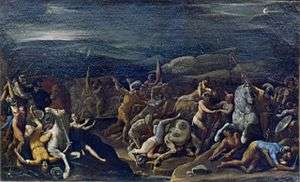Gaspare Celio
Gaspare Celio (1571 in Rome–November 24, 1640 in Rome) was an Italian painter of the late-Mannerist and early-Baroque period, active mainly in his native city of Rome.

Celio was the pupil of Circignani, according to Baglione, but of Cristoforo Roncalli, if we are to believe Abate Titi.[1]
His first commissions in about 1596 were completed with Giuseppe Valeriano who asked Celio to decorate the Chapel of the Passion in the church of il Gesù in Rome.[2] This work was done after the design of P. Giovanni Battista Fiammeri. He also paints a Madonna and Bambino, now in Santa Maria del Carmine, a The Passage of Moses through the Red Sea (1607) in a vault of the Palazzo Mattei, a Death of the Giants. He painted a St Francis for the altar of the Ospizio at Ponte Sisto. He painted a History of S. Raimondo at the Santa Maria sopra Minerva.[1]
Between 1620 -1638 he helps publish a guide to the churches and artwork in Rome (Memoria delli nomi dell'artefici delle pitture che sono in alcune chiese, facciate e palazzi di Roma). He engraved antique statues. He briefly worked in Parma as a painter for the court of Ranuccio Farnese.
He was buried in the Basilica of Santa Maria del Popolo, Rome, where still stands his funeral monument.
Works
- Works at the Capilla della Passione (1596), iglesia del Gesù, Rome
- Virgin and Child or Madonna (Santa Maria del Carmine)
- The Passage of Moses Through the Red Sea (1607), in the vault of Palazzo Mattei
- Death of the Giants Palazzo Mattei, Rome
- Works at the Capilla Altieri (1622), San Francesco a Ripa, Rome
- Ludovica Albertoni
- Saint Charles Borromeo
- Holy Family and Saint Anne
- St. Francis, an altar of the Ospizio at Ponte Sisto
- History of Saint Raymond, Santa Maria sopra Minerva
- Battle Scene (Borghese Gallery, Rome)
References
- The History of Painting in Italy from the Period of the Revival of the Fine arts, (1852) by Luigi Lanzi, translated by Thomas Roscoe, page 469)
- (in Italian) Cappella della Passione Archived 2007-07-02 at the Wayback Machine
Further reading
| Wikimedia Commons has media related to Gaspare Celio. |
- Sydney Joseph Freedberg (1978). Paintings in Italy, 1500-1600
- The Grove Dictionary of Art, Macmillan Publishers (2000)
- José Luis Colomer, Arte y diplomacia de la monarquía hispánica en el siglo XVII (Art and Diplomacy in the Spanish Monarchy in the 17th Century), CEEH (2003). ISBN 84-933403-0-8
- Comune di Bozzolo; Gruppo Culturale Per Bozzolo (a cura di), Il Principe e la Città. Giulio Cesare Gonzaga di Bozzolo, Modena, 1994. ISBN non esistente.